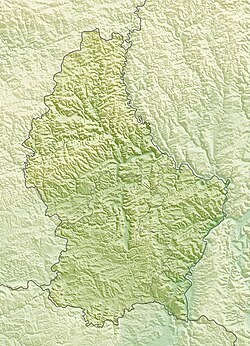The Luxembourg Sandstone (French: Grès de Luxembourg) is a geologic formation in Luxembourg. It exists along the eastern margin of the Paris Basin. Sandstone units continuous with the Luxembourg Sandstone also occur in France. It is Early Jurassic in age. It predominantly outcrops in a belt extending through south-central Luxembourg. It up to 100 metres thick and predominantly consists of carbonaceous poorly cemented sandstone and sandy limestone[1][2][3][4]
| Luxembourg Sandstone | |
|---|---|
| Stratigraphic range: Hettangian-Sinemurian ~ | |
 Outcrop of Luxembourg sandstone on a road construction site north of Luxembourg City | |
| Type | Formation |
| Sub-units | Grès de Bonnert |
| Thickness | 100 m (330 ft) in central Luxembourg |
| Lithology | |
| Primary | Sandstone, limestone |
| Location | |
| Coordinates | 49°42′N 6°00′E / 49.7°N 6.0°E |
| Approximate paleocoordinates | 38°06′N 8°24′E / 38.1°N 8.4°E |
| Region | Mersch |
| Country | |
| Type section | |
| Named for | Luxembourg |
Fossil content
editAmong others, the following fossils were reported from the formation:[5]
- Reptiles
- Ichthyosaurus communis[6]
- Temnodontosaurus sp.[7]
- Neotheropoda indet.[7]
- Plesiosauria indet.[7]
- cf. Theropoda indet.[7]
- Fish
- Gastropods[9]
See also
editReferences
edit- ^ BRIL, Koen VAN DEN; SWENNEN, Rudy (2009). "Sedimentological control on carbonate cementation in the Luxembourg Sandstone Formation". Geologica Belgica (in French). 12 (1–2). ISSN 1374-8505.
- ^ VAN DEN BRIL, KOEN; GREGOIRE, COLETTE; SWENNEN, RUDY; LAMBOT, SEBASTIEN (August 2007). "Ground-penetrating radar as a tool to detect rock heterogeneities (channels, cemented layers and fractures) in the Luxembourg Sandstone Formation (Grand-Duchy of Luxembourg)". Sedimentology. 54 (4): 949–967. Bibcode:2007Sedim..54..949V. doi:10.1111/j.1365-3091.2007.00868.x. S2CID 140135606.
- ^ Hendriks, Martin R. (April 1993). "Effects of lithology and land use on storm run-off in east luxembourg". Hydrological Processes. 7 (2): 213–226. Bibcode:1993HyPr....7..213H. doi:10.1002/hyp.3360070211.
- ^ Guerin-Franiatte, S.; Hary, A.; Muller, A. (1 July 1991). "La formation des gres du Luxembourg au Lias inferieur; reconstitution dynamique du paleoenvironnement". Bulletin de la Société Géologique de France (in French). 162 (4): 763–773. doi:10.2113/gssgfbull.162.4.763.
- ^ Luxembourg Sandstone at Fossilworks.org
- ^ Godefroit, 1995
- ^ a b c d e Delsate & Ezcurra, 2014
- ^ Duffin & Delsate, 1993
- ^ Monari et al., 2011
Bibliography
edit- D. Delsate and M. D. Ezcurra. 2014. The first Early Jurassic (late Hettangian) theropod dinosaur remains from the Grand Duchy of Luxembourg. Geologica Belgica 17(2):175-181
- S. Monari, M. Valentini, and M. A. Conti. 2011. Earliest Jurassic patellogastropod, vetigastropod, and neritimorph gastropods from Luxembourg with considerations on the Triassic–Jurassic faunal turnover. Acta Palaeontologica Polonica 56:349-384
- P. Godefroit. 1995. Un crâne d'Ichthyosaurus communis (Reptilia, Ichthyosauria) du Sinémurien supérieur de Lorraine belge. Bulletin de Société belge de Géologie 104(1-2):77-89
- G. Bloos. 1994. Frühe Arietitidae (Ammonoidea) aus dem Hettangium (Angulata-Zone, Unt. Lias) von Württemberg (SW-Deutschland). Stuttgarter Beiträge zur Naturkunde, Serie B (Geologie und Paläontologie) 219:1-67
- C. J. Duffin and D. Delsate. 1993. A new myriacanthid holocephalan (Chondrichthyes) from the Early Jurassic of Luxembourg. Neues Jahrbuch für Geologie und Paläontologie, Monatshefte 1993(11):669-680
Further reading
edit- H. Meier and K. Meiers. 1988. Die Gastropodenfauna der "Angulata-Zone" des Steinbruchs "Reckingerwald" bei Brouch. Travaux Scientifiques du Musée National d'Histoire Naturelle de Luxembourg 13:1-88
